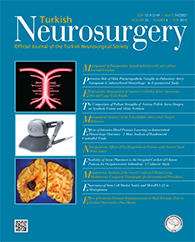2Necmettin Erbakan University, Meram Medical Faculty, Department of Neurosurgery, Konya, Turkey
3Necmettin Erbakan University, Meram Medical Faculty, Department of Radiology, Konya, Turkey
4Necmettin Erbakan University, Meram Medical Faculty, Department of Orthopaedic Surgery, Konya, Turkey DOI : 10.5137/1019-5149.JTN.10942-14.0 Aim: The sacral canal has been frequently used as a passage for minimally invasive diagnostic and therapeutic procedures for spinal diseases. The aim of the present study was to investigate morphometric analyses of the sacral canal, hiatus, and surrounding structures according to different age groups and gender by using the multidetector computed tomography method.
Material and Methods: Multiplanar-reconstructed images from 300 adult (150 females and 150 males, between 20 and 80 years old) were divided into three groups according to age and retrospectively examined. Various anatomic measurements of the sacral hiatus, surrounding structures, and sacral canal were performed. Sacral curvature angle and lumbosacral lordotic angle were noted.
Results: Bony anatomic abnormalities such as absent hiatus (0.3%), complete agenesis (1%), and bony septum (2.6%) were detected in some cases. The anteroposterior (AP) diameter of the hiatus was less than 2 mm in 5% of cases. In all groups, the mean values of the hiatus AP diameter and area, and the shortest distance of the sacral canal AP diameter were shorter in the 60-80 years age group when compared with those in 20-39 years age group (p=0.01). The shortest sacral canal AP diameter was commonly located at the S2 and S3 levels in 59.2% and 33.9% of cases, respectively. The levels of maximum curvature were at S3 and S2 in 63.3% and 26.7% of cases, respectively. Median sacral curvature angles and lumbosacral lordotic angles were measured as 164° and 134°, respectively.
Conclusion: Sacral structures have morphometric variations. Understanding of the detailed anatomy may improve the reliability of interventional procedures.
Keywords : Sacral hiatus, Sacral canal, Multidetector computed tomography, Interventional procedures




